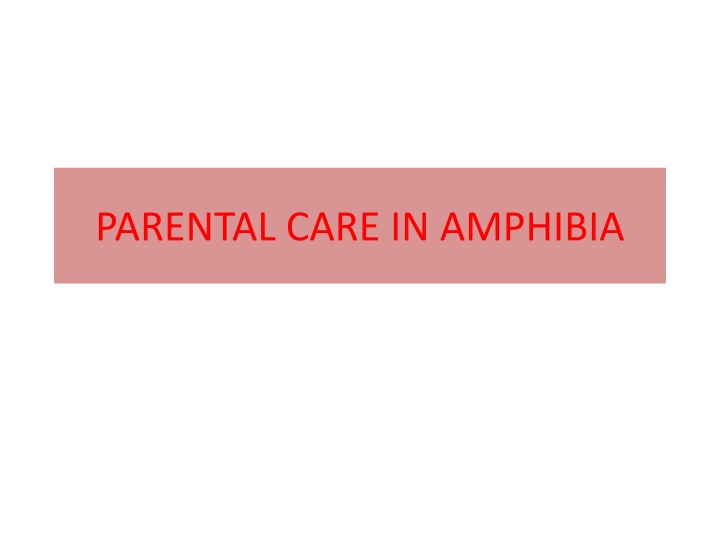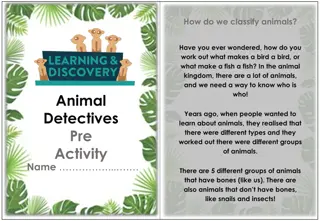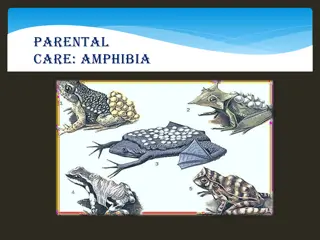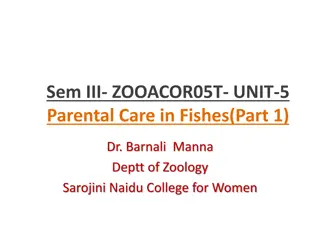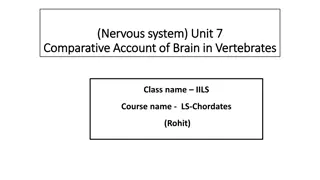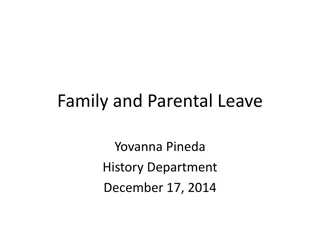Diverse Parental Care in Amphibians - An Insightful Overview
Amphibians, including anurans, urodelans, and apodans, exhibit a variety of parental care strategies to protect their eggs and offspring. From nest construction to direct nursing, different species showcase unique behaviors to ensure the survival of their young. Explore the fascinating world of parental care in amphibians through this comprehensive guide.
Download Presentation

Please find below an Image/Link to download the presentation.
The content on the website is provided AS IS for your information and personal use only. It may not be sold, licensed, or shared on other websites without obtaining consent from the author.If you encounter any issues during the download, it is possible that the publisher has removed the file from their server.
You are allowed to download the files provided on this website for personal or commercial use, subject to the condition that they are used lawfully. All files are the property of their respective owners.
The content on the website is provided AS IS for your information and personal use only. It may not be sold, licensed, or shared on other websites without obtaining consent from the author.
E N D
Presentation Transcript
PARENTAL CARE IN THE MEMBERS OF CLASS AMPHIBIA Amphibian include anurans, urodelans and apodans. In all these groups of amphibians we come across with a great deal of parental care. Amphibians show several mechanisms to protect their eggs and developing young ones because of the they lay few eggs.
Parents protect the eggs and early developmental stages in two ways. 1) They construct nests 2) Direct Nursing. The female Icthyophis glutinosa will dig a hole in the moist soil near a pond. It will deposit eggs in it. Around this egg mass the mother will coil and. protect the egg mass from the enemies Dermophis :it is viviparous in nature
Ichthyophis Icthyophis-glulinosa-parentalcare-amphibia
2. PARENTAL CARE IN E ORGANISMS OF URODELA: In some urodela amphibians the eggs are very small. They hatch end directly develop into larvae. In those organisms parental care is not required.
Protection by Nests :- ii)In transparent bags: EX:Salamandrella keyserlingi will construct a gelatinous bag like structure. It is attached to an aquatic plant below the water. In this bag eggs are stored. Thus they are protected by the Nest
i)In holes on land or in trees EX:Autodax will lay eggs in a dry hole on the soil or in a hole on a free. The parents also live in the hole and protect the egg and the larvae developed from them
Autodax Autodax-eggs1
b) Direct Nursing by Parents I) Amphiuma, (Congoeel) The mother will coil around the eggs and protect them. Ii)Plethodon-female lays eggs in groups of five under the stones and coils around them iii)Megalobatrachus maximus- male coils round the eggs and guards them
Amphiuma Amphiuma-congoeel-eggs
iv) Desmognathus fuscus, (the dusky Salamander) The mother will carry the eggs. They are attached around its neck.
Desmognathus Desmognathus-eggs
i) Salamandra maculosa, (the European fire salamander) :- The mother will retain few eggs in its body. It liberates the larvae into water. They complete their development in the water. ii) Salamandra atra, (the European alphine salamander) : The mother keeps the eggs in its uterus. It liberates only the young ones which are completed their metamorphosis.
3. PARENTAL CARE IN ANURA AMPHIBIANS: In Mura amphibians the parental care is reached its peak. Many organisms will exhibit parental care. a) Protection by Nests: Many frogs and toads build nests in which the eggs are laid and developed. This is a primitive method of parental care. In these organisms the larva comes out in a very early embryonic stage which requires some kind of protection in the very early stages of development, hence the parent will build nests.
I) Hyla Faber:- It is Brazilian free frog. The female will construct the nest in the shallow waters of a pond. The female will dig a hole of 8 to 10cm depth. The mud which comes out of it is used by the female Hyla to construct a wall around the hole. This wall is raisd above the level of water. Female Hyla will make the inner surface of this Nursery smooth and even the female will lay eggs in this nursery. The eggs and larval forms are protected inside this structure.
ii) Rhacophorus malabaricus, Phyllomedusa& Chiromantis: they lay eggs on the branches or leaves of a tree which will be hanging over a pond. These larvae after hatching from eggs will fall into the pond water and undergo metamorphosis.
lii Rhacophorus schlegeli It is called Japan Tree frog. Both male and female frogs will make a burrow in the moist soil near a pond edge .This hole is filled with foam by female. Then female lays eggs in this foam. The male and female animals will make an exit tunnel into the pond from the hole. The larvae developed from eggs will be carried by the liquid formed from the foam into the pond through these exit tunnels.
L iv) Hyla resinfectris It is a free frog. It will make use of holes in the frees. It will line the hole of free trunk with beewax brought from bee comb. Female animal lays eggs in this hole when filled with rain water. v) Leptodactylus mystacinus It digs a. hole in the moist mud near a pond. This hole is filled with foam which is secrete by the oviducts of the female. Female lays eggs in it. These eggs hatch into larvae then the pond will get good amount of water from rain. Then these holes are also surrounded by the pond water, Then the larvae will enter the pond and grow.
vi) Phrynixalus biroi: female prepares sausage shaped transparent gelatinous bags and lay eggs in them and leave it in mountain streams. after completion of development, small frogs come out of bag. Tail acts as respiratory organ in young ones and gills are absent.
vii) Hylodes : It is an American frog. It deposits its eggs in moist places or under the stones. The eggs hatch and give tiny adults in perfect condition.
2) Direct Nursing by Parents: This method is more advanced than protecting the eggs and larvae by constructing nests. 1) Alytes obstetricans: It Is called Mid-wife-toad When the eggs are laid by the female frog winds the strings of eggs round his back and thighs. This male frog lives in a shallow pit of the moist soil, It will came out of the pit now and then for feeding and to make the eggs moist. When the eggs are ready to hatch the male frog moves to a near by pond and the larvae are released.
Alytes Alytes
2. Nototrema marsupium: It is called New World brooding (or) Marsupial frog. It has a special pouch in its skin. It opens out through an opening near the cloaca. Fertilized eggs are transferred into this pouch. The eggs are stored in this pouch where they undergo development and tadpoles are liberated out.
3, Pipa americana It is called surinam toad. During breeding season the skin of the back of the female becomes soft and spongy. During copulation the oviducts will come out of the female- Because of the movements of male the eggs are forced out of the oviduct. Each egg sinks into a small pocket of the skin. It gets coveted by an operculum. In the soft maternal tissue the young one can develop safely. The developing embryo has a tail and yolk sac. It has no gills. The tail may work like placental connection to draw nutrition from the mother. Nearly after 80 days small individuals may come out.
Pipa pipa Pipa-americana
4. Rhinoderma darwini It is called little South American frog. The fertilized eggs are transferred into its vocal sacs the development takes place. Then the completely developed young individual will jump out from the mouth of the male frog.
Hyla geoldii: posterior part at the back of the female forms brood pouch in which eggs are placed Rhacophorus reticulatus: female carried the eggs on the belly which bears impressions of the eggs when they are removed Hylambates: eggs are carried in buccal cavity of the female Arthroleptis : males carry the larvae in the mouth Rheobatrachus:female keeps the eggs in the stomach. Tadpoles are come out through mouth
Viviparity: two small east African toads Pseudophryne vivipara and Nectophryne tornieri are viviparous and give birth to young ones. They retain eggs in oviducts
